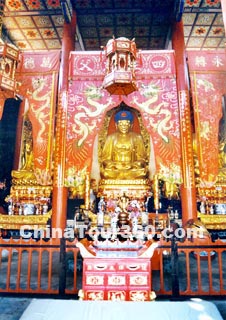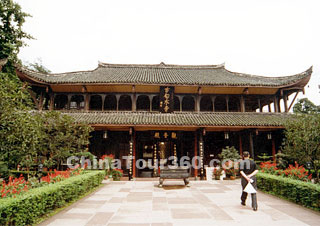
A Statue of Buddha
Buddhism, one of the three major religions in the world, was created by Sakyamuni, the historical Buddha living in northeast India between 563 and 483BC. It was widely spread in many Asian countries and introduced to China in the Eastern Han Dynasty (25 - 220). Different from the other religions, Buddhism is pure antitheist, which means followers do not believe in the creation and domination of a god. Generally speaking, Buddhism includes sutras, ceremonies, practices and organizations. While in a narrow sense, it is just Buddhist teachings.
Buddhism in China began to develop quickly in the Northern and Southern Dynasties (386 - 589), when Buddhists and Buddhist temples appeared in a great number. It came to its peak in the Sui (581 - 618) and Tang (618 - 907) dynasties. Although emperors of the Sui Dynasty believed in Buddhism, while the emperors of the Tang Dynasty believed in Taoism, they all adopted lenient and protective policies towards the other religions. As a result, Buddhism gradually matured. In the late period of the feudal society, Buddhism began to decline because of the popularity of superstition. Then, it gained a new lease of life after 1945. After long-term development and evolvement, Buddhism in China can be divided into three major branches, including Han, Tibetan and Southern Buddhism.
![]() Tibetan Buddhism
Tibetan Buddhism

Tibetan Buddhists
Also named 'Lamaism',it means a spiritual teacher or spiritual guide. Tibetan Buddhism has rich Buddhist sutras, among which the most well-known one is Tripitaka made up of Gangyur and Tengyur. In the seventh century, Princess Wencheng of the Tang Dynasty and Princess Bhrikuti of Nepal both carried with them Buddhist statues and sutras when they married Songtsen Gampo, King of Tibet then. Influenced by the two princesses, Songtsen Gampo began to believe in Buddhism and constructed the Potala Palace, the Jokhang Temple and the Ramoche Monastery. In the mid-eighth century, Buddhism was directly introduced into Tibet from India. In the late-tenth century, Tibetan Buddhism formed. Then, it was spread into Mongolian areas in the mid-thirteenth century. Thereafter, many featured branch sects formed, mainly including Ningma, Sakia, Kagyu and Gelug.
Ningma Sect is the oldest sect of all and Ningma means 'ancient' or 'old' in Tibetan. It was so named because it mainly spread the old Buddhist sutras of the Tubo Period (630 - 842). Ningma Sect emphasizes the cultivation of heart and nature. Sakia Sect originates from the Sakia Temple which has the most Buddhist scriptures among the Tibetan Buddhist temples. Sakia Sect pays attention to the translation and debate of the scriptures. Kagyu Sect aims to build the body, and they usually pass on the principles by dictation of Esoteric Buddhism. Gelug Sect has strict disciplines. They think that the disciplines are the root of Buddhism, so Buddhists should practice what they preach according to the rules. Meanwhile, they believe in that the emergences of all the rules are the result of specific causes. Besides, they also strive to increase their knowledge about grammar, trope, medicine and the celestial almanac.
Living Buddha, also named 'Zhugu', 'Lama' or 'A La', is the most important clergy of Tibetan Buddhism. He is the embodiment of the Buddha, enjoying a supreme position among the religious people. He could induct the believers to become Buddha. In 1193, Marpa Choikgilodroi, founder of the Kagyu sect, told his followers that he would have a reincarnation after his death when he was dying. The reincarnation of Living Buddhas was inaugurated since then.
![]() Han Buddhism
Han Buddhism

Wannian Temple at Mt. Emeishan
Also named Mahayana Buddhism, it is believed in by part of the Han people and the Bai, Naxi, Yi and Lahu ethnic minorities. It is subdivided into many sects in China during the developing process, including Tiantai Sect, Sanlun Sect, Falv Sect, Lv Sect, Jingtu Sect, Chan Sect, Huayan Sect and Mi Sect.
Since its introduction into China, Han Buddhism has combined with traditional Chinese culture. In painting, famous painters of many dynasties were good at Buddhist paintings. For example, Cao Buxing of the Wu State in the Three Kingdoms Period (220 - 280), Gu Kaizhi and Wei Xie of the Jin Dynasty (265 - 420), are regarded as the three earliest Buddhist painters in Chinese history. In sculpture, the Buddhist murals in Mogao Caves, Yungang Grottoes and Longmen Grottoes are all gems of Buddhist culture. In architecture, all sorts of building types can be found in a Buddhist temple, including palace, hall, pavilion and corridor. Besides, the translation of Buddhist sutras has great influence on the development of Chinese phonology and translation theory. Buddhism had also helped to promote the development of Chinese medicine, history and celestial almanac.
In the beginning, the Han Buddhists just wore a large square-shaped cloth in the way of wrapping one side of the cloth around the right shoulder from the left rib. Later, the color and style of their clothes increases gradually, and they only wear the canonical clothes on Buddhist festivals or when hold Buddhist fairs. They can wear their special ordinary clothes during the rest time. For example, Buddhists wear gowns in three different lengths, respectively named 'long gown' with hemline at the ankles, 'short gown' with hemline at the knees, and 'half gown' with hemline covered the knees.
The important Buddhist festivals include Sakyamuni's Birthday on 8th day of the fourth Chinese lunar month, Shakyamuni's Enlightenment Day on the 8th day of the eleventh Chinese lunar month and Shakyamuni's Nirvana Day on the 15th day of the second Chinese lunar month. Of all the Buddha, Guanyin (Kwan-yin) and Dizang (Ti-tsang) Bodhisattvas are the most popular amongst the Han people who will hold Buddhist rituals on the birthdays of the two Bodhisattvas.
![]() Southern Buddhism
Southern Buddhism
Also named Hinayana or Theravada Buddhism, it is the oldest existing branch of Buddhism. Because it adopted Pali language as its typical scripture language since the first century BC, it is also named Pali Buddhism. At present, the countries believing in Southern Buddhism are Sri Lanka, Myanmar, Thailand, Laos, Cambodia, Vietnam and China.
Southern Buddhism in China is believed in by Dai, Bulang, Deang, Achang and part of the Wa ethnic minorities, mainly distributed in Xishuangbanna, Dehong, Simao, Lincang and Baoshan autonomous prefectures of Yunnan Province. The Buddhist scriptures are divided into two categories, one is transliterating sutras, and the other is sutras of free translation. In those scriptures are recorded with some practical knowledge such as literature stories, history, folklores, allegories, celestial almanac, law and medicine. Originally, the characters were carved on the palm tree leaves, known as palm-leaf scriptures.
Southern Buddhism has had deep influence on the Dai people's social life and culture. Dai language, Dai calendar and Dai people's religious festivals are all products of integration of Southern Buddhism and the local culture. According to the tradition, a boy of the Dai ethnic minority group has to be acolyte for a certain period of time ranging from a week to months when he reaches a certain age. Then, the majority part will return to laity, but a few ones will stay and continue cultivating their morality to be Buddhists.







